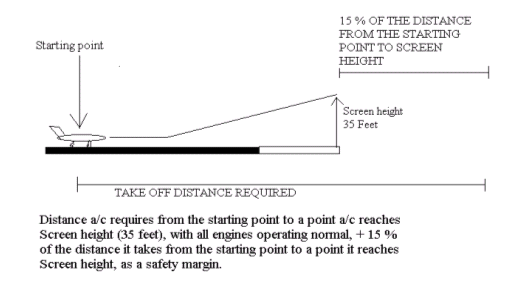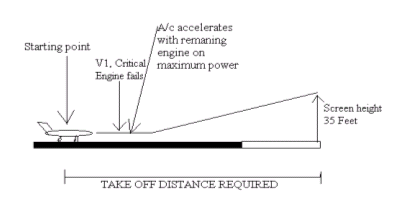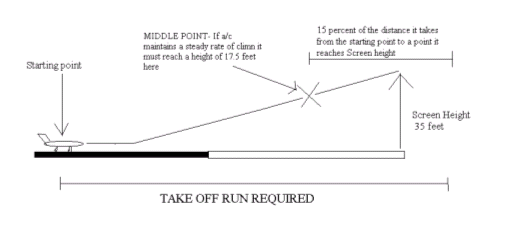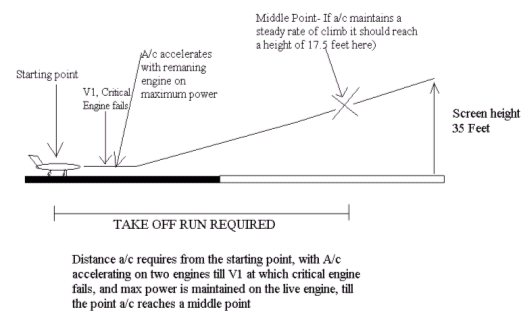Density altitude is the pressure altitude corrected for temperature and pressure.
In I.S.A conditions the Density altitude is same as Pressure altitude.
In temperatures above I.S.A conditions or on a hot day, the density altitude goes higher than pressure altitude.
High Density altitude conditions cause engine performance to decrease.
Since the high Density altitude means that the temperature is hot and the air density is low. On take off the aircraft requires a longer Take off run to become airborne.
Low Density conditions cause engine performance to increase.
Since the low Density altitude means that the temperature is cold and the air density is high. It improves the engine performance.
TAKE OFF DISTANCE REQUIRED (TODR)- is the greater of the following
- Distance a/c requires from the starting point to a point a/c reaches Screen height (35 feet), with all engines operating normal, +15 percent of the distance it takes from the starting point to a point it reaches Screen height, as a safety margin.

- Distance a/c requires from the starting point to a point a/c reaches Screen height (35 feet), with A/c accelerating on two engines till V1 at which critical engine fails and, and max power is maintained on the live engine, till the point a/c reaches Screen height (35 feet).

————————————————————————————–
TAKE OFF RUN REQUIRED (TORR) – is the greater of the following
- Distance a/c requires from the starting point, with all engines operating normal to a Middle point +15 percent of the distance it takes from the starting point to a middle point, as a safety margin. Middle point is a point which lies in the middle of lift off and Screen height (35 feet), (If a/c maintains a steady rate of climb it should reach a height of 17.5 feet here)
- Distance a/c requires from the starting point, with A/c accelerating on two engines till V1 at which critical engine fails, and max power is maintained on the live engine, till the point a/c reaches a middle point. Middle point is a point which lies in the middle of lift off and Screen height (35 feet), (If a/c maintains a steady rate of climb it should reach a height of 17.5 feet here),
————————————————————————————–
ACCELERATE STOP DISTANCE REQUIRED (ASDR) – is the distance required for an a/c from the starting point to coming to a complete stop, following a/c accelerating till V1 at which critical engine fails with max power on the live engine, action is initiated for rejection with all means of retarding, including speed brakes application if available, except the usage of Thrust Reversers.
BALANCE FIELD LENGTH (BFL) – is the condition when
TAKE OFF DISTANCE REQUIRED (TODR) = ACCELERATE STOP DISTANCE REQUIRED (ASDR).
LANDING DISTANCE REQUIRED (LDR) – is calculated by assuming a/c to be at a height of 50 feet above the threshold, on V.REF speed (V.REF = 1.3 VSO in Landing Configuration) maintaining a steady rate of descent, in ISA conditions, + 67 percent of actual distance required as a safety margin, which when added to the Actual landing distance is called Factored Landing Distance.
Un Factored landing Distance – is the actual landing distance required by the a/c with given atmospheric conditions, taking into account all the other variables, like Runway slopes, Existing Temperature and winds, Airfield elevation and aircraft weight.
Factored Landing Distance – is the distance which includes a safety margin of 67 % to the Actual Landing Distance for the Destination airfield and includes a safety margin of 43% to the Actual Landing Distance for Alternate Airfield.
Wet Runway – requires Landing Distance Required to be increased to 15 percent as a safety buffet, since a wet runway causes ineffective braking.


